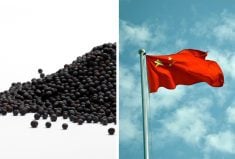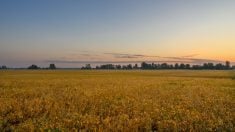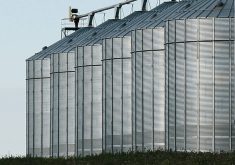SOUTH
Wet, humid conditions have not stopped haying with about 80 percent of the crop baled or put into silage. About 10 percent is ready for baling. Approximately three-quarters of the crop is rated as good.
Precipitation ranged from trace amounts to 54 millimetres in the Bengough area. The Moosomin area leads the province with the most rain, having received 612 mm since April 1.
Crops are quickly advancing, however more rain is needed to help later seeded crops fill and recover from the heat. Most are in the podding or filling stages and development remains behind normal.
Read Also

Canada and China discuss disputes over canola and EVs, says Ottawa
Senior Canadian and Chinese officials discussed bilateral trade disputes involving canola and electric vehicles on Friday, Ottawa said, but gave no indication of any immediate breakthrough.
Damage to crops was caused by strong winds, heavy rain and large hail. Some producers are spraying for grasshoppers.
About three-quarters of topsoil moisture on cropland and hayland is rated adequate. More than half of the pastures are rated in good condition.
CENTRAL
Rain and high humidity is affecting swath drying. About 70 percent of the hay crop has been baled or put into silage with 15 percent ready to bale. About three-quarters of the crop is rated as good.
Some crops are catching up in development, but most are behind normal stages.
Rain varied from trace amounts to 70 mm for the Kamsack and Major areas. The Rhein area has had the most rainfall since April 1 with 554 mm. Most crop damage was caused by strong winds and heavy rain and hail. Some of the hail damaged fields are being cut for feed.
Some spraying continues for leaf spot diseases and grasshoppers.
Topsoil moisture on cropland and hayland average about 85 percent adequate. Pasture conditions are rated about 65 percent good.
NORTH
Haying has generally been slowed down by wet conditions and high humidity. About three-quarters of the crop is baled or in silage. Approximately 10 percent is ready to bale. Hay quality is declining and about 80 percent is rated as good.
Crops are generally looking good but large amounts of rain has lodged and damaged crops in some areas. Rainfall amounts varied from 20 mm to about 75 mm in the Meadow Lake area. The North Battleford area has received 446 mm of cumulative rain since April 1.
Topsoil moisture on cropland, hayland and pastures are all rated at more than 90 percent adequate. Pasture conditions are rated as 75 percent good.














